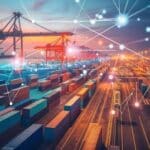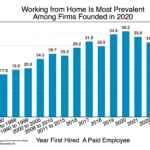An Introduction to the Internet of Things
“Psst, hey you, look over here. No, in the kitchen. It’s your refrigerator. You’re almost out of eggs, and you could probably use some more bacon …”
Welcome to the future, where Internet of Things (IoT) appliances generate your shopping lists. None of the smart refrigerators I’ve looked at work quite like the cute conversation above, but sensor-laden IoT technology has benefited sectors like supply chain/logistics/transportation, manufacturing, agriculture, energy, healthcare and more for years.
The Internet of Things (IoT) Definition
At its most basic definition, the IoT uses sensors to embed computer power into everything – connecting vehicles, buildings, machinery, inventory, computers, software, etc. These “things” interact with each other and their environment, offering real-time visibility and data.
Five Examples of I0T
Here are real-world examples of IoT:
- IoT can notify you when inventory is low.
- IoT can tell you when a CNC machine needs maintenance.
- IoT can remind you when your crops need water.
- IoT can warn you when your electrical grid needs a boost from a partner’s electrical grid.
- IoT can tell a doctor when a patient’s vital signs go awry – even when that patient is at home on the couch.
Better data drives better decisions, from customer service to logistics to healthcare.
Current estimates put the world’s number of IoT devices at 15.14 billion, growing to 29.42 billion connected devices by 2027. For comparison, the global population is only 8.1 billion.
The Internet of Things in Transportation
For your supply chain, logistics and transportation operations, the IoT embeds sensors in almost anything: manufacturing machinery, inventory, trucks and other vehicles, packages and containers, throughout warehouses to monitor inventory levels, in heavy machinery to monitor conditions and detect potential maintenance issues, loading docks, customs checkpoints, smart lockers for final-mile delivery – the list is endless. Connected devices can monitor temperature, humidity, location, vibration and even inventory damages.
The IoT can even help create digital twins of your warehouses and supply chain networks – a virtual reality representation of your physical layout, inventory, equipment and workflows. Digital twins offer real-time insights to help you optimize operations, reduce costs and increase productivity. They also allow you to model changes before implementation, so rapid analysis can replace lengthy pilot projects.
IoT implementation is an essential part of a Digital Supply Network, which uses artificial intelligence, machine learning and the cloud to form a multiparty network that links all raw materials/components/parts from their entrance into your end-to-end supply chain until their exit as finished goods.
Industrial Internet of Things
The IoT also can help transform the personal transportation, manufacturing, agriculture and energy sectors.
- Transportation: Audi collaborated with a German logistics firm to demonstrate how vehicle-to-vehicle communication reduces accidents and costs. Enhanced safety and autonomous vehicles also apply to public transit systems.
- Manufacturing: IoT systems can monitor and enhance production processes, track inventory, assist with quality control, help with customer relationship management and more.
- Agriculture: The IoT can help farmers mitigate environmental challenges and water scarcity by monitoring environmental conditions and crop production while optimizing crop rotations, fertilizer application and irrigation. Producing food, fibers, livestock and industrial crops currently consumes 70% of global groundwater withdrawals.
- Energy: IoT-enabled electrical grids can communicate with each other to optimize power distribution while helping customers and enterprises save on electricity expenses.
As you can see from these developments, much of the future is now, but much is yet to be written. Are you looking to leverage the IoT for your business? Feel free to contact us to discover how.
Jim Tompkins, Chairman of Tompkins Ventures, is an international authority on designing and implementing end-to-end supply chains. Over five decades, he has designed countless industrial facilities and supply chain solutions, enhancing the growth of numerous companies. He previously built Tompkins International from a backyard startup into an international consulting and implementation firm. Jim earned his B.S., M.S. and Ph.D. in Industrial Engineering from Purdue University.







Jim,
I’m glad you called this out. This is an area I have been working in for years as you say has begun to be highly relevant in many parts of our lives, but none more importantly than in the industrial world.
In fact, as you mentioned there is a whole separate IOT called the IIOT (Industrial Internet of Things) that exists. Besides the use cases you mentioned, where this gets really exciting to me is when we combine IIOT sensors, Edge Computing, AI/ML models, and relevant data to produce predictive and prescriptive analytics. These capabilities that we are just now plumbing, take things to new levels of productivity and safety.
Imagine autonomous, self-managed outbound packing stations that automatically optimize both packaging and rate/route calculations.
Imagine a system of systems that can help manufacturers see the signal in the noise and accurately know their actual demand through gathering and analysis of market, consumption, and customer sales/prior order data.
Truly an exciting time to come!
Neil: We are 100% aligned. We are just scratching the surface of what can be done when we integrate of power of real time information with AI/ML. The future is not an extension of the past, but a whole new ball game.
Jim